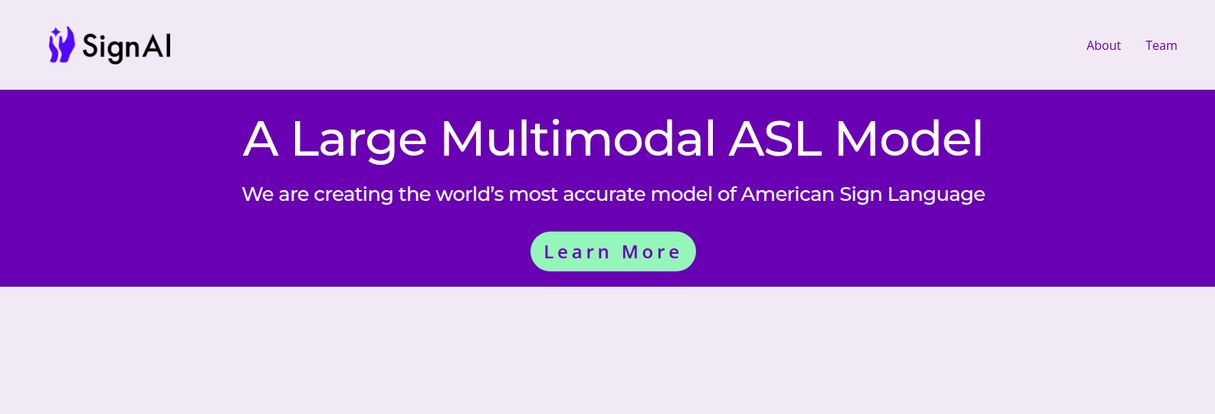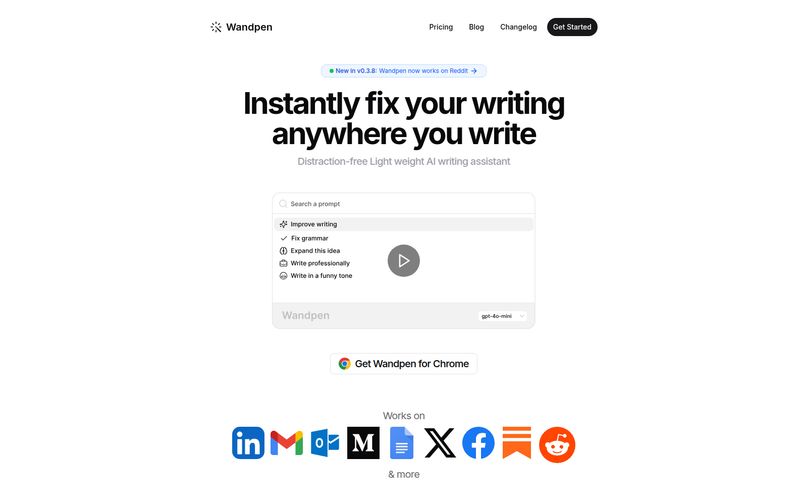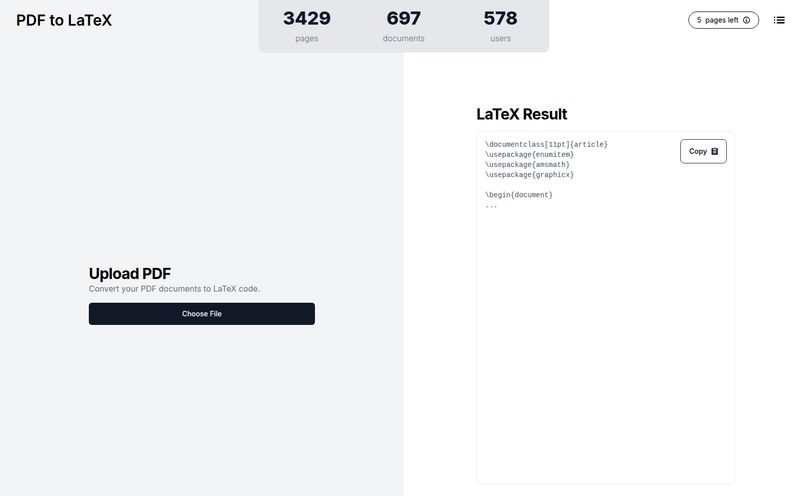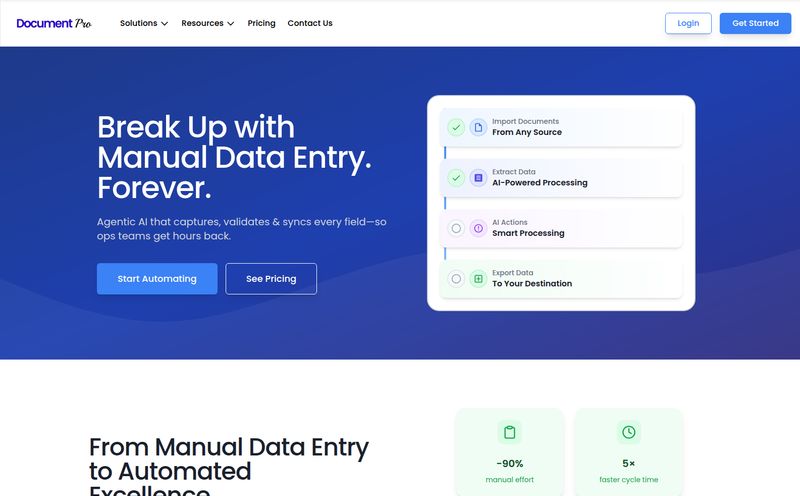I’ve been in the SEO and digital trends game for a while now, and you start to see patterns. Every so often, a piece of tech pops up on my radar that makes me lean in a little closer to the screen. Not just another SaaS tool promising to 10x my whatever, but something genuinely… different. Something that feels like it’s pulled from a sci-fi novel. This week, that something was a company called SignAI.
Their claim is simple, yet incredibly ambitious: to be the world's first virtual, real-time, AI-powered American Sign Language (ASL) interpreter. Available on demand, anytime, anywhere.
Yeah. Let that sink in for a second. It’s a huge swing.
So, What Exactly is SignAI Claiming to Do?
From what I've gathered on their homepage, SignAI is building what they call a “Large Multimodal ASL Model.” In non-tech-speak, they’re creating a sophisticated AI that can understand and translate American Sign Language in real time. The term “multimodal” is doing a lot of heavy lifting here. It suggests the AI can process multiple types of input—in this case, the visual and grammatical complexities of a signed language—and translate it into spoken or written language, and presumably, vice-versa.
The goal is to bridge the communication gap for the Deaf and Hard of Hearing (HoH) community. Think about it: a doctor’s appointment, a parent-teacher conference, a quick chat with a barista. The idea is to make interpretation accessible instantly, through a screen. Its a pretty massive undertaking.

Visit Sign AI
The entire concept feels less like an app and more like a fundamental shift in accessibility services. For years, we've talked about web accessibility in terms of alt-text and keyboard navigation. This is a whole other level.
The Promise: Why This Could Be a Game-Changer
My initial reaction? Wow. The potential here is enormous. Anyone who has ever tried to book a human ASL interpreter knows it’s not exactly like ordering a pizza. There’s a well-documented nationwide shortage of qualified interpreters. This can mean long waits, high costs, and sometimes, no interpreter at all. It’s a serious bottleneck that affects millions of people's access to healthcare, education, and basic services.
SignAI, in theory, smashes that bottleneck. An on-demand service means no more scheduling an interpreter weeks in advance for a 15-minute meeting. It means a Deaf person could, potentially, have a fluid conversation with a hearing person anytime they need to. It’s the sort of on-demand convenience we've come to expect in other areas of our lives, finally applied to a critical accessibility need. This isn't just a tool; it's a potential lifeline. It’s like having a universal translator from Star Trek, but for a language spoken by hundreds of thousands of people right here on Earth.
Let's Pump the Brakes: The Obvious Hurdles
Okay, the SEO-professional-cynic in me has to step in now. As exciting as this is, my brain immediately starts flagging the potential problems. And they are not small.
The Deep Nuance of Language
First off, ASL is not just a collection of hand gestures you can program into a machine. It's a complete language with its own grammar, syntax, and regional variations. A huge part of its meaning comes from facial expressions, the speed and size of the signs, and body language. Is a sign a question or a statement? The difference might just be in the signer's eyebrows. Can an AI truly capture that level of subtlety? The difference between “You’re going to the store” and “You’re going to the store?!” is everything. I have my doubts an AI, at least in its current state, can consistently nail that human element.
Accuracy Is Everything
Then there's the accuracy problem. The stakes are incredibly high. If an AI misinterprets a casual chat between friends, it’s awkward. If it misinterprets a doctor explaining a medical diagnosis or a lawyer discussing a legal case, it's catastrophic. The platform’s success hinges entirely on its reliability. A 95% accuracy rate might sound great for a marketing email tool, but for medical interpretation, that 5% error rate is terrifying.
The Inevitable Tech Dependency
And of course, it all depends on technology working flawlessly. A stable, high-speed internet connection. A good quality camera. Decent lighting. We've all been on a Zoom call that glitched out at the worst possible moment. Now imagine that happening during an emergency 911 call being translated by SignAI. It's a factor that can't be ignored.
My Own Little Investigation (and a Broken Link)
Being the curious person I am, I went to their homepage to poke around. Big, bold letters promised the “world’s most accurate model of American Sign Language.” Okay, impressive. I saw the “Learn More” button and, naturally, I clicked it.
And… I hit a 404 page. A dead end.
Now, I’m not throwing stones. I’ve launched enough websites to know that stuff happens. More than anything, it’s a sign (pun intended) that SignAI is likely in its very early stages. They’re building the plane while flying it, and that’s okay. It just tempers the excitement with a dose of reality. This is a project with a long road ahead.
I also couldn't find any information on pricing. Will it be a subscription model? A pay-per-minute service? Free with ads? The business model will be a huge factor in its adoption. For now, it remains a mystery.
The Bigger Picture for SEO and Digital Accessibility
Putting aside the product itself, let's think about the ripple effects for those of us in the digital marketing world. A tool like this could radically change how we approach video content and web accessibility. Imagine being able to automatically generate an accurate ASL interpretation overlay for every video on your website or YouTube channel. The increase in reach to the HoH community would be massive. It would move the needle on accessibility from a compliance checkbox to a genuine effort at inclusion. For content creators and brands, this represents a whole new audience to connect with.
This is the kind of trend that gets me excited about the future of the web. It's not just about getting more clicks or traffic; it's about using technology to build a more inclusive internet.
Frequently Asked Questions about SignAI
What is SignAI?
SignAI is a tech company developing what aims to be the first real-time, AI-powered virtual interpreter for American Sign Language (ASL). It's designed to be available on-demand to help bridge communication gaps for the Deaf and Hard of Hearing community.
How does SignAI work?
It uses a Large Multimodal AI Model. This means it's being trained to understand the visual complexities of ASL—including handshapes, facial expressions, and body movement—and translate them into written or spoken language, and likely the other way around as well.
Is SignAI a free service?
As of right now, there is no public information available about SignAI's pricing. Their website is still in the early stages and doesn't list any subscription or one-time payment models yet.
Can SignAI completely replace human interpreters?
That seems highly unlikely, at least for the foreseeable future. The nuance, cultural understanding, and emotional intelligence of a human interpreter are incredibly difficult to replicate. SignAI is more likely to serve as a powerful supplementary tool, especially for immediate, on-the-spot needs where a human interpreter isn't available.
What language does SignAI support?
Currently, all of their messaging indicates a focus on American Sign Language (ASL).
Where can I find more information?
The primary source is their official website, signai.ai. However, be aware that the site seems to be under active development, so some pages or information might not be fully available yet.
A Cautiously Optimistic Look Ahead
So, where do I land on SignAI? I’m cautiously optimistic. I’m rooting for them. The world needs a tool like this to succeed. The potential to empower millions of people is undeniable. But I'm also a realist. The path from a great idea to a reliable, trustworthy, and nuanced product is long and fraught with challenges, especially when dealing with the complexities of human language.
I’ll be keeping a very close eye on SignAI. This is one of those moonshot projects that, if they pull it off, won't just create a successful business—it'll genuinely make the world a more accessible place. And that's a trend worth getting behind.
What do you think? Am I being too skeptical? Or not skeptical enough? Drop a comment below, I'd love to hear your take.
Reference and Sources
- SignAI Official Website: https://www.signai.ai/
- National Association of the Deaf (NAD) on ASL Interpreters: https://www.nad.org/about-us/position-statements/position-statement-on-american-sign-language-interpreters/



